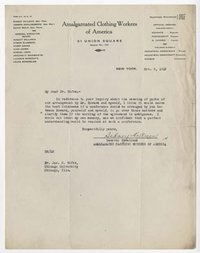
The Hart, Schaffner and Marx Labor Agreement grew out of the unsuccessful nineteen-week strike of workers in the Chicago men's clothing industry in 1910. It was initially signed by representatives of the workers and Hart, Schaffner and Marx, largely at the instance of Joseph Schaffner, and represented a compromise between the United Garment Worker's (UGW) demand for a closed shop and management desire for an open one. Under the agreement of March 13, 1911, an arbitration board was set up for the settlement of shop grievances. It was composed of Clarence Darrow for the workpeople and Carl Meyer for the company. Inasmuch as Dean Wigmore of Northwestern Law School, whom they chose as impartial chairman, was unable to serve, the two functioned alone. Early in 1912, a trade board, with joint representation, was set up as a court of first resort when shop chairmen (UGW agents) and foremen were unable to settle disputes on the floor. James Mullenbach was impartial chairman of this body from its inception until 1935. At the same time, John E. Williams became impartial chairman of the arbitration board, holding the position until 1919, when he was succeeded by James H. Tufts. In 1914, a supplementary agreement established a "preferential shop," based on the system obtaining in the New York market, and giving the UGW preference in hiring. At the same time, the Arbitration Board was given power under an "emergency clause" to adjust wages.
Online Collection and Finding AidAccess Information
The collection is open for research.